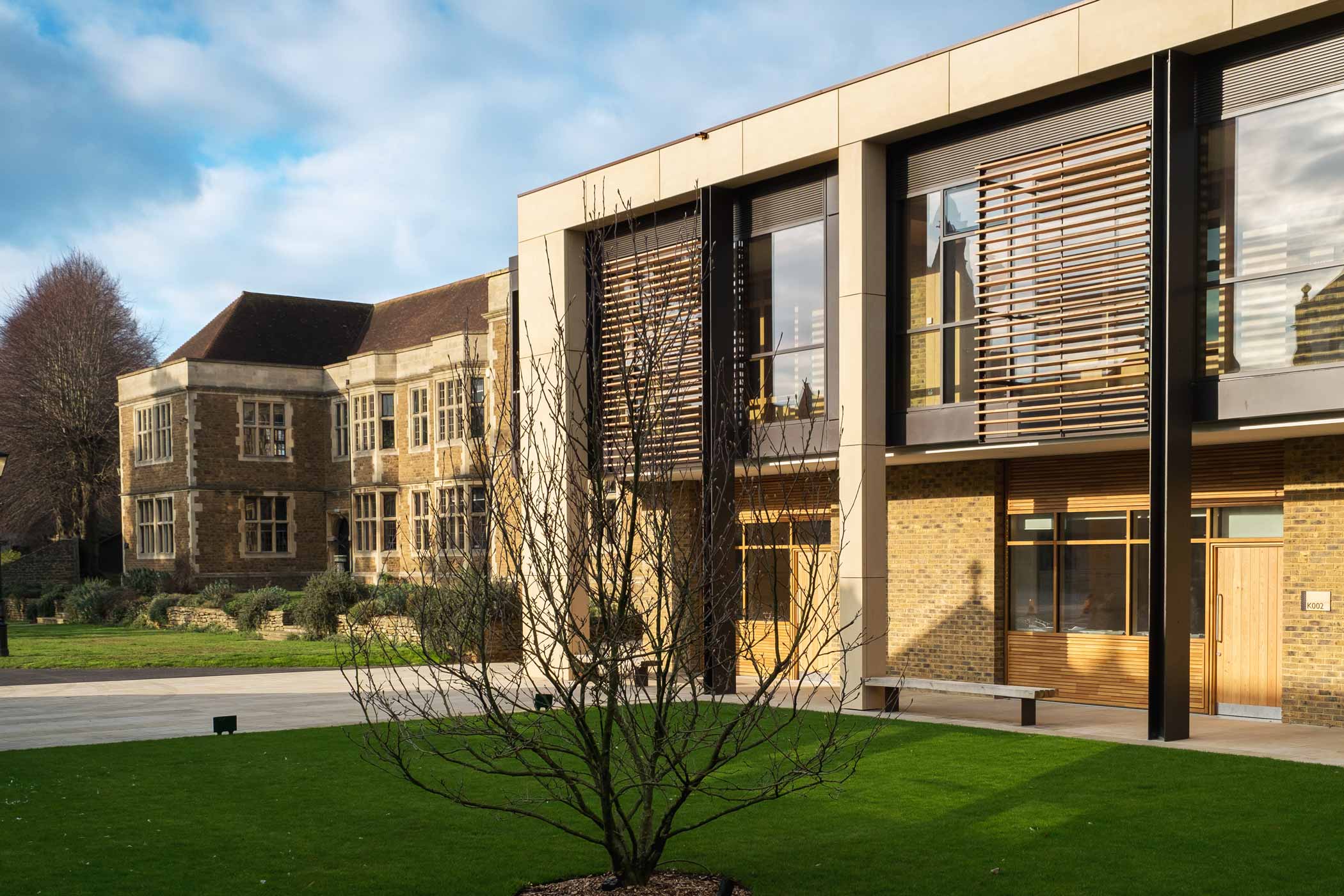
Charterhouse Science & Maths
- location:
- Godalming, Surrey
- client:
- Charterhouse School
- role:
- ArchitectureSignage Consultant
- sector:
- Education
- status:
- Completed 2019
Three steeply pitched roofs aid the internal, functional requirements of the labs and provide a focal point to the vista
Design Engine originally won the commission to design the new state-of-the-art science and mathematics facilities after an invited competition in 2009, beating a strong field including Hopkins, Belsize Architects, Panter Hudspith and Pringle Richards Sharratt.
Founded in 1611, Charterhouse is one of the great historic public schools of England. With four centuries of history behind it, the School is committed to being at the forefront of educational progress in the twenty-first century. The School’s aim was to revolutionise the way Science and Mathematics subjects are taught at Charterhouse by fostering inter- and intra-departmental collaboration, providing a world-class learning environment for current and future generations of pupils.
- 50% more space overall, comprising 7 new chemistry laboratories with wet and dry teaching areas, 5 mathematics classrooms, 2 preparation rooms and a project research room
- A flexible and modern environment of the highest quality
- More scope to innovate in the development of new teaching methods, ensuring Charterhouse continues to lead the way academically
- The co-location of Science and Mathematics for the first time, fostering greater collaboration
- Additional space for practical work and the potential to introduce longer-running experiments which will no longer need to be dismantled at the end of each class


The Site
Awards
RICS Award, Design Through Innovation, Shortlist
2019
RIBA Award, Regional South East, Winner
2019
Brick Awards, Education Category, Shortlist
2019
WAN Awards, Education Category, Shortlist
2019
Civic Trust Award, Winner
2020
The existing Science and Museum buildings are in the heart of the school grounds. This location provides a strong basis on which to increase the building’s existing legibility. By connecting all parts of the new Science Centre development, the existing building is re-established as the ‘front door’ or threshold to the Centre. The new Chemistry Block provides a dynamic and modern frontage addressing the main view on approach into the school from Prince’s Drive.
The new connecting wings provide a link between new and old but form important external ‘forum space’ with the courtyards connecting to the main pedestrian area of the school.


Site Strategy
Design Team
- main contractor:
- Total Construction Ltd
- project manager:
- Ridge
- structural engineer:
- Heyne Tillet Steel
- quantity surveyor:
- Fanshawe
- fire consultant:
- Sweco
- acoustic consultant:
- Sustainable Acoustics
- planning consultant:
- Turleys
The site lies towards the North Eastern edge of the campus. Characterised by the historic architecture and setting, the buildings, largely designed by the Architect Philip Charles Hardwick, are predominately Gothic Revival / Neo-Gothic in nature, dating back to the late 19th and early 20th Centuries.
Our scheme, featuring three steeply pitched roofs expressing the 6 Chemistry Labs below, creates a subtle but important architectural link to the original campus which is heavily reliant on these forms.
Not only does this roof articulate a building form which is contextually appropriate, but also provides a focal point to the vista from the primary entrance to the school on Prince’s Drive, as well as providing the appropriate form to deal with the internal and functional requirements of the Chemistry Labs within.

North Elevation
The proportion of the colonnade and the northern facade have been been developed using the Golden Rectangle. This has been introduced to create another subtle but important architectural link between the original Gothic campus which in itself is heavily reliant on that proportioning system.
The spacing established with the colonnade uses a simply repeated vertical Golden Rectangle which is sub-divided into a pure square sitting below a smaller horizontal Golden Rectangle. This subdivision enables the controlled placing of a brise soleil band creating a facade which is both rhythmic and layered.
This is a very well-considered addition to a forgotten corner of the campus of a large independent school. The design developed over many years and through several changes of the client structure. This allowed the project to mature and distill a super-contextual approach to the many differing adjacent buildings and constraints.
RIBA Awards Citation South East Awards 2019

Concept
Articulated by the steep roofs and ventilation chimneys to the Northern elevation, it is this form which describes the central concept for the laboratory spaces.
These chimneys provide an outlet for the fume cupboards within but also a volume which facilitates natural ventilation through stack effect. Thus, they serve a dual purpose of providing a necessary functional requirement, but also a subtle reference to the historic context.
To achieve an appropriate form and massing for the building, a series of physical and computer models became an essential tool during the design process. Physical modelling was used extensively throughout the design process to explore the various options.
Pitching the roofs helped moderate between a low scale and robust form to the South whilst maintaining the strong vertical elements of the Chimneys, important in creating and signifying entrance to the school and maintaining a contextual link to the historic setting of the campus.


We are delighted with our new Science and Mathematics Building and the new inspirational spaces within which to work and learn. Design Engine and the Contractor have worked hard to meet our briefing needs and have delivered a top class facility of which the school is rightfully proud.
Emma humphreys, Estate Bursar, Charterhouse School




